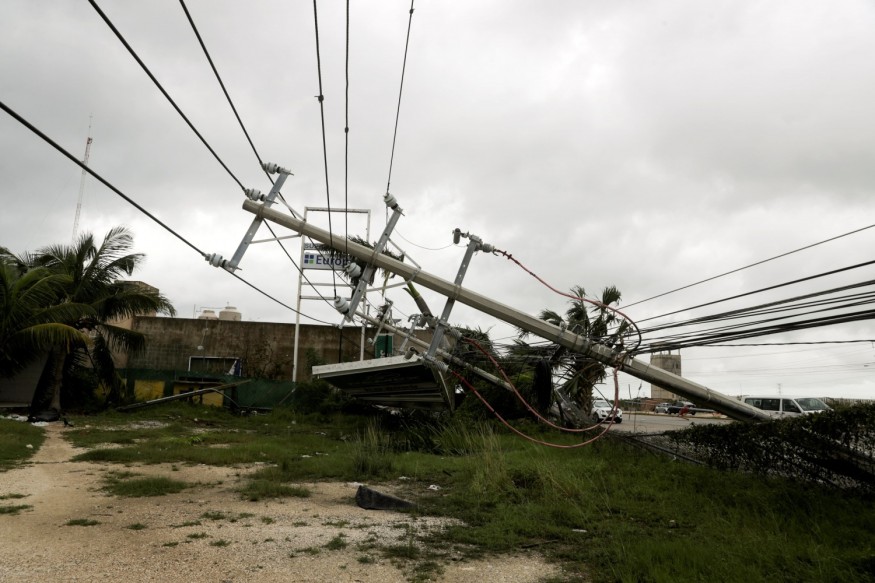Hurricane Delta also left Yucatan Peninsula on Wednesday and is expected to regain its strength as a significant storm as it makes its way to the US Gulf Coast.
The category two hurricane hit Puerto Morelo at estimated maximum winds of 105 mph, halfway between the tourist resorts of Cancun and Playa Del Carmen at around 6:30 am US east coast time.
Residents were earlier warned that Hurricane Delta is expected to bring "life-threatening storm surge and strong winds to northeastern portions of the Yucatan peninsula."

READ: Delta Intensification: Now a Category 4 'Major' Hurricane as It Heads for Mexico and the USA
Heading to US Gulf Coast Similar to Hurricane Laura
Hurricane Delta hit Yucatan Peninsula on Wednesday early morning causing the evacuation of tens of thousands of residents and holiday-makers to emergency shelters as it lashed out on popular tourist resorts.
Meanwhile, High Island, Texas, eastward to Grand Isle, Louisiana were issued a hurricane watch as the hurricane finds its way to the US.
National Hurricane Center issued a storm surge watch for High Island to the Alabama-Florida border.
According to weather experts, Delta's projected path looked similar to Hurricane Laura which was a Category 4 storm that made landfall in Louisiana on August 27. The previous hurricane left 15 people dead, hundreds of thousands with no electricity for days or weeks, and damaging more than 10,000 homes in southwest Louisiana.
READ ALSO: France-Italy Flood Aftermath: 12 Dead, More Missing, Corpses Washed from Cemeteries
The Delta's Path to the US
National Hurricane Center forecasts that Delta will make landfall along the northern US Gulf Coast on Friday. Residents of Louisiana and east Texas to Mississippi are warned to brace themselves with storm surge flooding, strong winds, and rainfall flooding.
On Wednesday evening, microwave satellite imagery suggests strengthening of Delta as convection was becoming more tightly wrapped around its center.
Delta is also expected to gain strength on Thursday night due to warm waters in the Gulf of Mexico, and lower wind shear along its path as it heads northward towards the US Gulf Coast.
The wind intensity may diminish in the Gulf Coast due to upper-level winds and colder waters. However, weather experts still warn that despite that, Delta is still a formidable hurricane at landfall in Louisiana and Upper Texas on Friday.
This hurricane is expected to move inland through lower Mississippi Valley then into Ohio Valley on Saturday.
States Prepare for Hurricane Delta
On Tuesday, Louisiana Governor John Bel Edwards and Alabama Gov. Kay Ivey declared a state of emergency on their respective states to prepare for the storm and position the state for a pre-landfall disaster declaration with the Federal Emergency Management Agency. Gov. Tate Reeves also declared a state of emergency in Mississippi on Wednesday.
Edwards urged South Louisiana residents to monitor the weather in the coming days and heed the advice and directions of their local officials.
Louisiana schools throughout the Gulf Coast region will be closed Thursday and Friday.
Tourists at the Alabama Gulf Coast were ordered a mandatory evacuation.
Governor Ivey warned that the storms are unpredictable and encouraged everyone to take Hurricane Delta seriously.
Mississippi distributed 160,000 sandbags to low-lying counties and prepared nine shelters on standby to open if necessary.
US Bureau of Safety and Environmental Enforcement said that nearly 10% of manned oil rigs were also shut down in preparation for the storm.

READ NEXT: Tropical Storm Delta: A Potential Tropical Storm that Maybe A Danger to US Gulf Coast this Week
Check out more news and information on Hurricanes on Nature World News.
© 2025 NatureWorldNews.com All rights reserved. Do not reproduce without permission.





